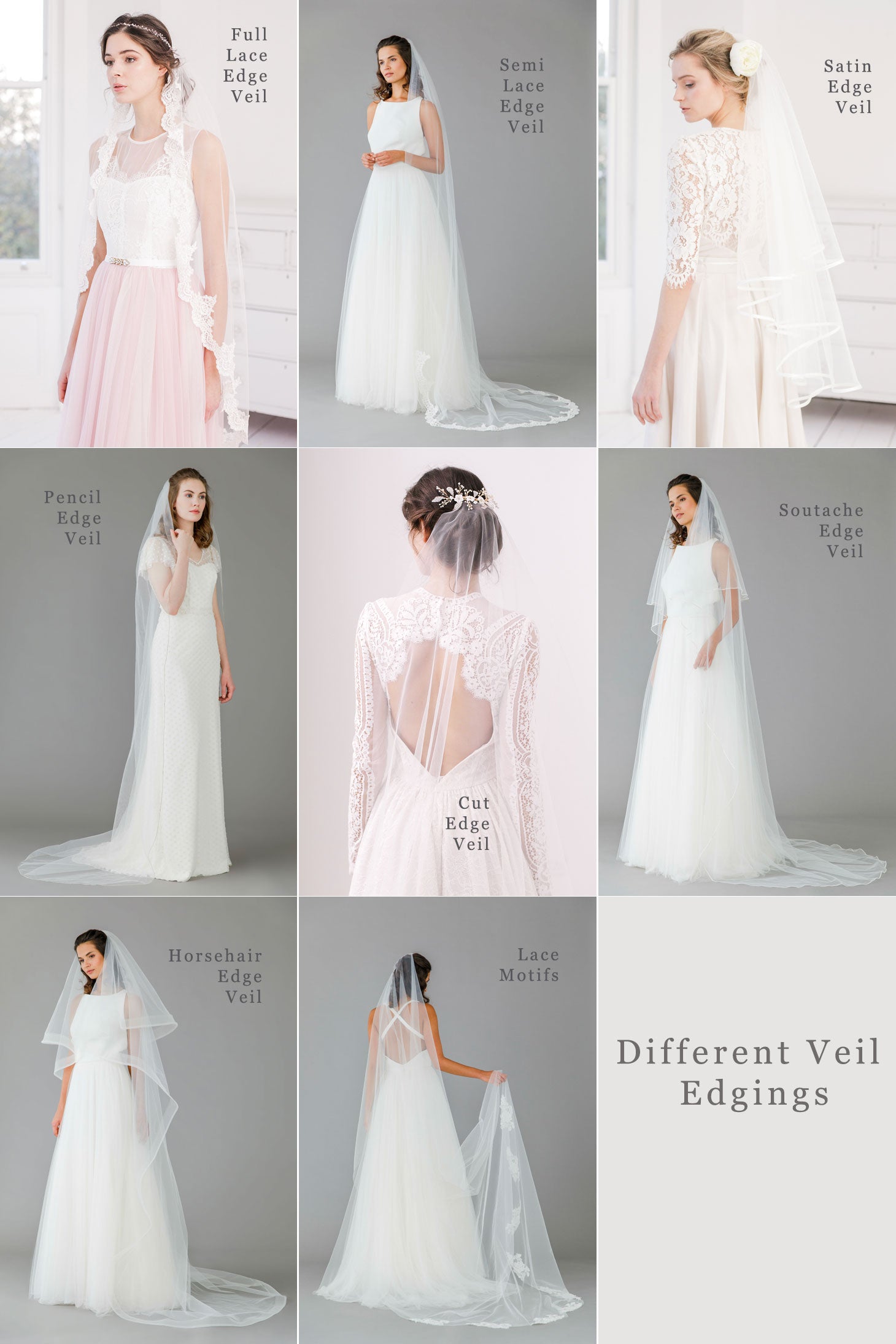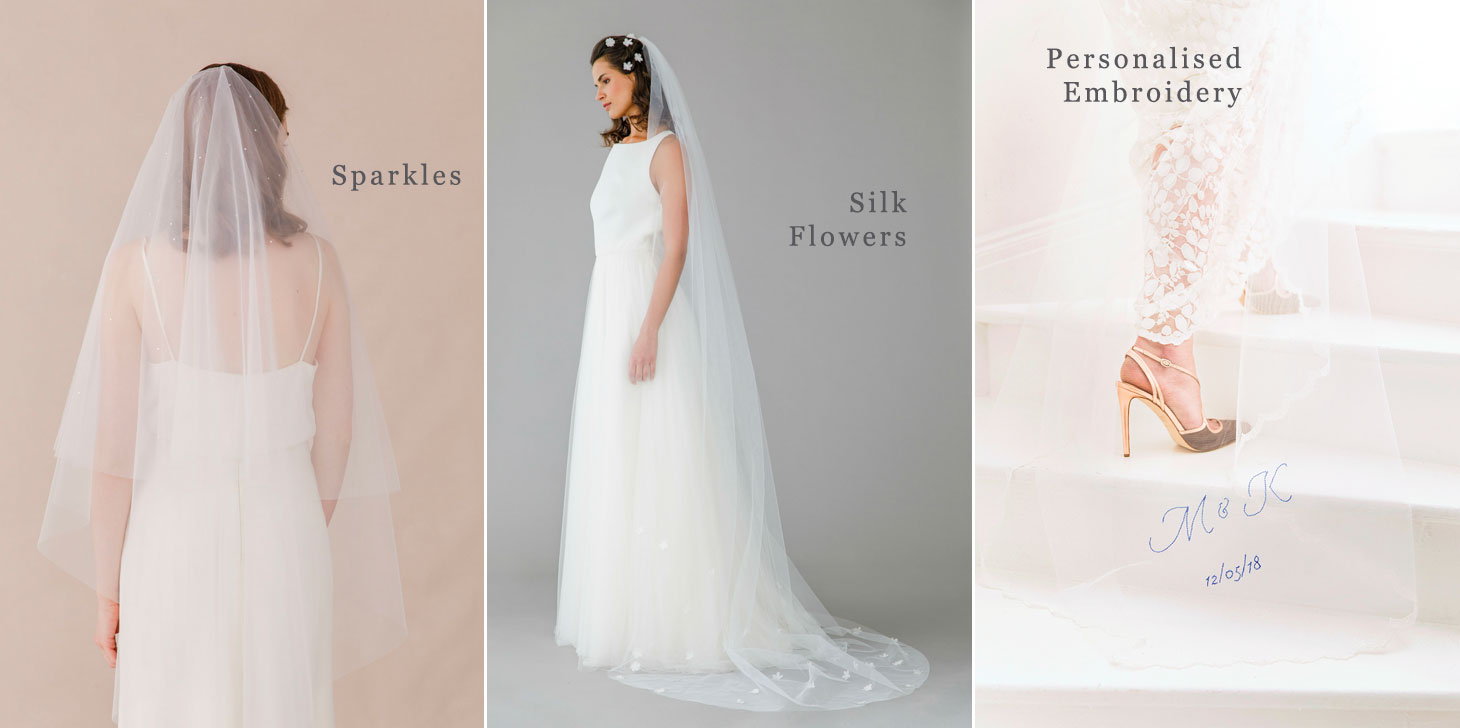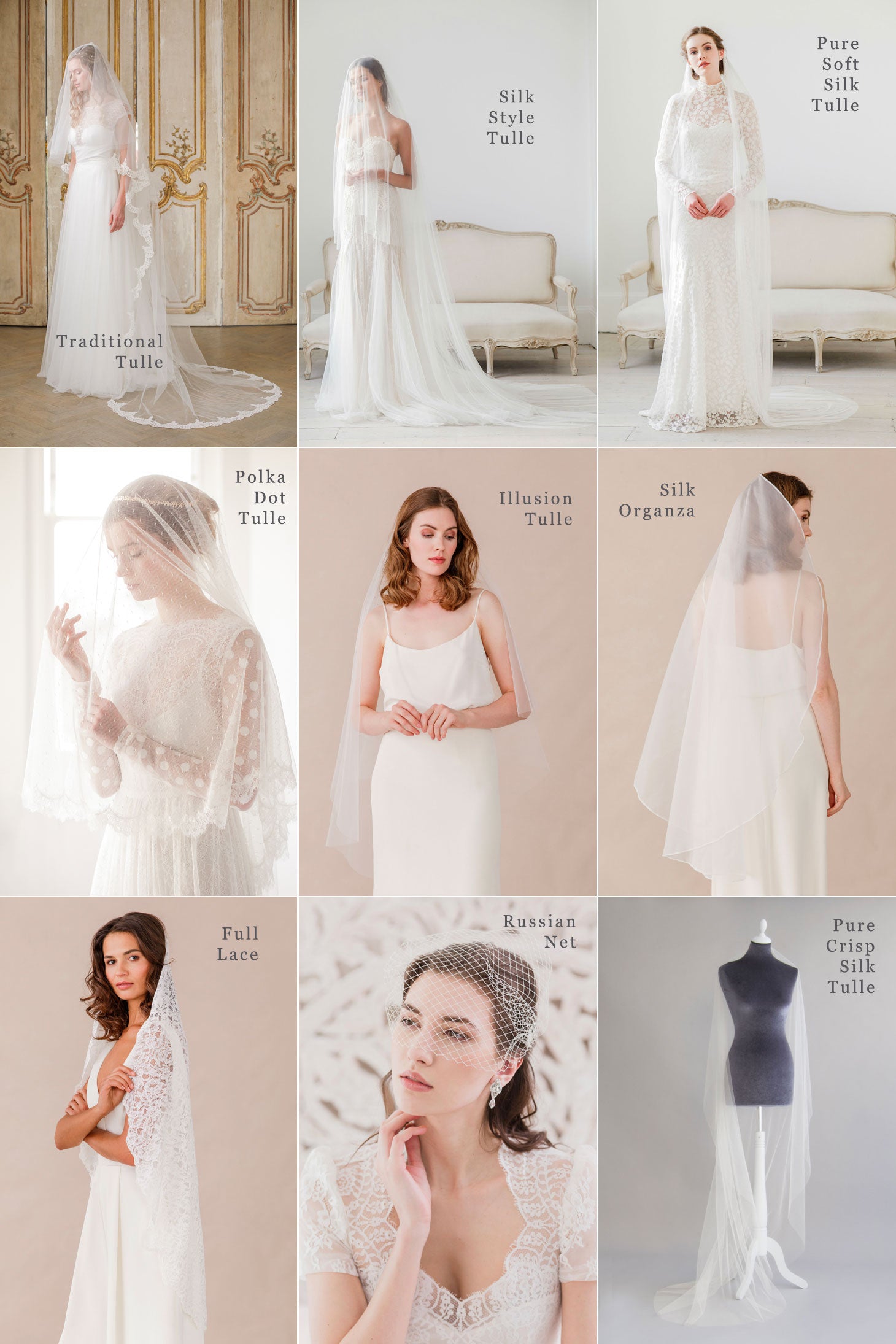The Britten Guide to Wedding Veils
At first glance wedding veils can seem quite intimidating; what even is a blusher?! In truth they are not hard to grasp, it's just lack of familiarity that makes them seem scary.
Before we get down to the details you may have noticed that while we have an extensive range to choose from we don't offer a 'build your own veil' option.
When we send a veil we have to know that it will look wonderful, the box has our name on it, so our range is carefully designed and curated to look fantastic on all brides. If you'd like more customisation than we can offer online then please do get in touch, we're always happy to have a chat about what you need.

What are the different types of veil?
- Single tier wedding veils- These are what most people imagine when asked to picture a veil. Single tier means that the veil flows from it's attachment point (normally a comb) down the back. There is no blusher, section of veil in front of the face. These can have a full gather or no gather at all like our 'barely there veils'. See real brides wearing single tier veils.
- Two tier wedding veils- means that the veil includes a 'blusher' which can be pulled forward over the face. This is raised during the ceremony for the first kiss or at the exact moment you are married and is then swept back over the head to form a second layer at the back of the veil. We make our blushers 72cm long but they can be made to any length if requested. Remember you may be carrying a bouquet, would you like the veil to finish above the bouquet or drape over it? See real brides wearing two tier veils.
- Barely there veils- this refers to the way the veil is cut rather than the fabric used, these veils will have no gather to them making them perfect for showing off all the beautiful detail on the back of your dress! See real brides wearing barely there veils.
- Waterfall veils- these are somewhere between a single tier and a two tier! They have a beautiful waterfall effect at the top but are still sheer enough to see all the details of your dress. See real brides wearing our waterfall veils.
- Drop veils- this is a two tier veil with no gather. They are often held in place with a headband, (as shown in our images for our 'Rhiann' drop wedding veil,) or hair pins. If you don't plan to wear any other accessories we can sew an invisible comb into our drop veils. Click for our 'How to secure a drop wedding veil' guide. See real brides wearing drop veils.
- Mantilla veils.This is a single tier veil with no gather. We sew a comb to the top of the veil so it can be worn at the top of the head. They are sometimes described as Spanish veils. See real brides wearing mantilla veils.
- Juliet veils. A 'cap' of material holds the veil in place. This is a traditional vintage look, dating from 16th century England. It is believed the design dates to actors performing Juliet in the original performances of Shakespeares 'Romeo & Juliet'. See real brides wearing Juliet veils.
- Drape veils. These veils have two combs and a 'drape' drop between them. These are beautiful for showing off a back necklace such as our Charlotte lariat.
- Cape veils. Not really a veil at all but a cape. These can be tulle or lace or a combination of the two and are a great alternative to a traditional veil.
- Bandeau veils. These are a more vintage feel and attached either side of the head. Some makers use this term interchangeably with 'birdcage' veils. They are technically wrong but the terms are beginning to merge somewhat so check images to be sure! See real brides wearing bandeau veils.
- Birdcage veils. These are attached at the top of the head (similar to the way a birdcage hangs). This terms can be used interchangeably with 'bandeau' on the internet, check the images to be sure!

Wedding Veil Length Options
The names imply the setting they are expected to be used in but don't be put off. If you want to make a dramatic entrance to a small chapel then go for it and order the cathedral length; by contrast if you are getting married in a huge church or venue but wouldn't feel comfortable in a long veil then ignore the names and order what you like. For longer veils we normally recommend they are about 20-30cm longer than the end of your dress. To work this out measure from the top of your head where you plan on wearing the veil straight down your back to the end of the train of your dress. If this measurement was 220cm our church length (250cm) would be perfect for you. We can make all our veils in any length.
- Cathedral length wedding veils. Our cathedral length veils are 300cm long and trail beautifully. The trim option you choose will determine how the tulle moves as you walk, more information on this is below.
- Church length wedding veils (also called chapel sometimes). Our church length veils are 250cm long and still trail like the cathedral version, it's just a little shorter.
- Floor length wedding veils. We make our floor length veils 200cm long. They should touch the floor with a small trailing edge that will vary according to your height. Without a long trail floor length veils move more freely in any breezes and as you move.
- Ballet length wedding veils. We make our ballet length veils 150cm long, they fall to about mid calf length.
- Fingertip length wedding veils. As the name implies these should fall somewhere around your fingertips with your arms at your sides. At 122cm long there will be some natural variation depending on your height.
- Elbow length wedding veils. These veils are 72cm and generally fall around the elbows.

Wedding Veil Colour Options
These are pretty simple really. The main three colours we offer are ivory, off white and white. Our ivory is a warm colour with a slight creaminess, off white is a very pale ivory/ soft white and white is an optic white. We also stock champagne and blush pink in the traditional tulle. The tulle colour does not need to match your dress exactly they just need to tone in well together- if in doubt go one shade lighter than your dress. If you are unsure then order our traditional tulle colour samples or our silk style tulle colour samples.

Veil Edging Options
We have various edging options. You can buy our lace sample packs to compare the lace to your wedding dress. Don't worry they don't need to match exactly, you just want them to compliment each other. You can also buy our veil edging swatch samples.
- Full lace edged wedding veils. A lace edge runs all the way around, right up to the comb. The delicate lace frames the face and gives the most dramatic effect possible. A lot of the lace we use, both at Britten and our sister company The Wedding Garter Co, comes from an English firm established since 1858 and still owned by the same family. It's now run by the 8th generation of the family and it's safe to say they make the best lace in the world. Not only do they provide the finest quality ecclesiastical lace to the church but they also supplied the lace for the dress worn by the Duchess of Cambridge to Prince William in 2011. See real brides wearing full lace edge veils.
- Semi lace edged wedding veils. A combination of cut edge and lace edge- a great option if you don't want a full lace edged veil. You can have the lace start and finish anywhere you would like. See real brides wearing semi lace edge wedding veils.
- Satin edge veils. A satin edge runs all the way around the veil giving it more structure. See real brides wearing satin edge veils.
- Pencil edge veils. A very fine line of stitching runs around the whole veil. We can do this in most colours. See real brides wearing pencil edge veils.
- Cut edge wedding veils. A cut edged veil is very much lighter and more delicate than edged versions. For this reason it allows other accessories more attention and moves much more freely in light breezes; it's a beautiful effect. See real brides wearing cut edge veils.
- Soutache edge veil. A soutache braid is somewhere between a pencil edge and a satin edge, it gives the veil a lovely finish and slightly more structure than pencil edge. We can do this in most colours.
- Horsehair edge veil. A horsehair edge gives the veil a great deal of structure and the veil almost bounces! It is a fabulous effect! See real brides wearing horsehair edge veils.
- Lace motifs. Lace motifs are stitched to the veil at various points to create different effects.
- Bespoke edge- We can edge our veils in a variety of other options, get in touch!

Additional Veil Finishes
- Sparkles- twinkling crystals adorn your veil. We can only attach crystals to our silk style tulle or illusion tulle.
- Silk flowers- hand cut silk flowers are sewn to your veil. We can do this in many colours.
- Personalised embroidery- To make your wedding veil extra special and personal to you we can hand embroider two initials and your wedding date to any of our veils.

Veil Fabric Options
You can buy samples of veil fabrics from Britten Weddings here.
- Our 'traditional tulle' which has a little body and volume and gives you that very traditional veil look. This is the original veil fabric! Our's is made in Somerset and made from a very high quality Nylon. The best thing about this tulle is it's strength, even though it is exceptionally fine it can support a lot of lace and detail without loosing it's lightness. See real brides wearing traditional tulle veils.
- Our 'silk style tulle' which drapes and falls like silk without the hefty price tag. Silk style tulle is very soft and falls straight down with no volume at all, as it is so delicate it does have a tendency to catch so if your dress is heavily embellished our traditional or illusion tulle maybe a better option. This tulle works best with slim fitting dresses. Like our traditional tulle this is also made in Somerset and is made from a polyester thread. This tulle is also known as an English net. See real brides wearing silk style veils.
- Our 'pure soft silk tulle' which is one of the most luxurious of all our tulles, it drapes and handles beautifully. Like silk style tulle it has a tendency to catch on embellishments and also works best with slim fitting dresses. This tulle is made in France - a country famous for luxurious fabrics.
- Our 'polka dot tulle' which is covered in tiny dots, it is also know as swiss dot tulle. It adds a little more texture and interest to the veil. Our polka dot tulle is soft and falls more like our silk style tulle than our traditional tulle.
- Our Italian tulle is a stunning new fabric for us which is made in Florence, Italy. It is really popular for wedding veils as not only does it have a beautiful drape, it can support all kinds of lace and crystal embellishment, it can be embroidered and as the 'holes' are really small it won't catch on embellished dresses. Our most luxurious non-silk tulle!
- Our illusion tulle which is a soft tulle that falls between our traditional and silk style in terms of body and structure. The 'holes' in the fabric are tiny and as such this works beautifully if you have a very embellished dress as it won't catch. It is very similar to Italian tulle.
- Our silk organza which has more body than the other fabrics and is less sheer. This is also made of a pure silk thread. Perfect for a modern look!
- Our full lace veils which are a beautiful alternative to tulle and give you a bit more coverage.
- Our russian net veils which are normally either birdcage or bandeau.

In addition to all this where you wear your veil alters how it looks- check out our handy blog post.
Its also a good idea to consider how to fix your veil in your hair before the big day!
Finally you need to consider how to store your veil. We have quite a few different options.


















